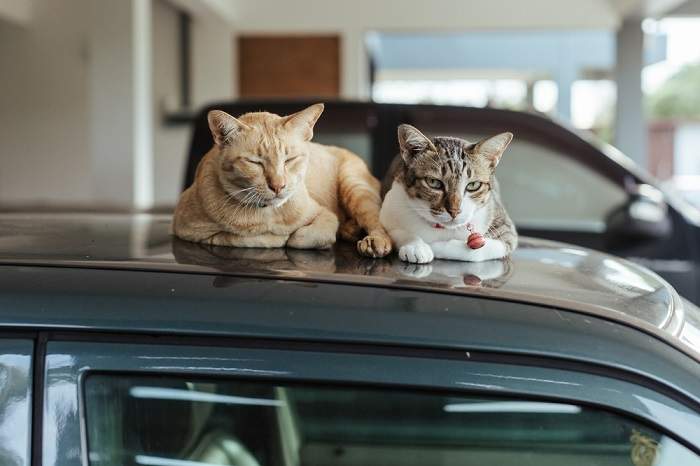
Have you ever come home to find your cat peeking down on you from the top of the refrigerator? Or perhaps you’ve found books and ornaments knocked down from your bookshelves with your cat giving you the innocent “it must have been a poltergeist” eyes, despite the dusty paw prints giving their game away? If so, you are not alone! Cats are hard-wired to want to climb and be high, and the reasons for this cat behavior are fascinating.
Being up high offers cats several advantages, including the ability to see further away to look for danger and remaining out of reach of potential threats. Being up high creates a sense of safety for your cat, which is why cats sometimes choose to hide somewhere high up. Enriching your cat’s environment by creating vertical space allows them to express natural behaviors, which can help to reduce stress.Key Takeaways
So Why Do Cats Like To Be High Up?
The drive for cats to find a high-up hidey place is hard-wired in their natural instincts, even for indoor cats. When we think of cats in general, we perceive them to be predatory hunters waiting to pounce on their next unsuspecting prey item.
However, did you know that cats are also prey animals? In the wild, small feline species are at threat of attack by creatures such as large birds of prey, coyotes, wolves, or foxes for example.
This means that your cat is naturally always on alert for dangers and looking for a safe place to be. By hiding away up high, your cat can get a better view of their surroundings, allowing them to see threats but also to feel safely hidden away from them.
Why You Need Vertical Space at Home for Your Cat(s)
Providing your cat with vertical space to explore allows them to display these naturally driven behaviors at home. If cats do not have the opportunity to express their natural behavior patterns, this can sometimes lead to behavioral problems due to stress, frustration, or boredom.
These can, in turn, be challenging to resolve without the input of your veterinarian or a licensed animal behaviorist. As a pet parent, it’s essential to try and provide as much enrichment as possible for your cat to meet their behavioral needs and keep them happy and healthy.
Vertical space also significantly increases the amount of living area your cat has to live in. This can be hugely helpful if you live in a multi-cat household. Social dynamics in homes with two or more cats can be a little complicated, and even if your cats are seemingly the best of friends, they need to have their own space and resources (such as food and water bowls or a litter box) placed away from one another.
Resource guarding in cats can be subtle and can easily lead to stress for your cat. By making the most of the vertical space in your home, it’s easier to spread resources about the house so everybody can access what they need without worrying about bumping into another cat on the way.
How Can I Make Vertical Spaces for My Cat
There are loads of great resources and products for creating fabulous vertical spaces for your cat, whatever your budget. Below we think about a few of the possible options:
1. Cat Trees
There are countless different cat trees out there to fit every home aesthetic and every possible budget. Cat trees often provide a combination of hidey holes, cat beds, climbing spaces, and scratching posts to meet many of your cat’s natural behavioral drives, making for a great enrichment toy in your cat’s home.
If you want to explore some of our top cat tree picks for 2023, click here.
2. Wall-Mounted “Cat Superhighways”
If you have been researching vertical spaces for your cat, you will probably have seen the extravagant options available for wall-mounted “cat superhighways” on social media. These are combinations of ladders, shelves, bridges, platforms, beds, and hidey holes, all fixed to your walls for your cats to climb and explore.
These can be as elaborate as you want, and some people choose to extend them to several rooms around the house (it’s OK to limit to one room if you would rather). While great for your cat, this option is not for everyone as they take up space and can quickly become expensive unless you are great at at DIY.
3. Shelves

If your cat enjoys perching in your bookshelves, you can buy and modify one specifically for them.
If you like the idea of a “cat superhighway” but are on a minimal budget, or perhaps you can’t bring yourself to cover your walls with a cat super highway of platforms and stepping stones, then some low-cost shelving units can work as a handy compromise.
Purchasing a cheap shelving unit and cutting some cat-sized holes in the shelves can make for a great, on-a-budget, vertical space for your cat without taking over your entire living space. Use wall mounting brackets to ensure the shelf won’t fall over if your cat gets the 3am zoomies!
4. Window or Radiator Beds
A simple, budget-friendly solution is to purchase a cat bed that attaches to a window sill, a window pane, or a radiator. This gives your cat somewhere safe to sleep that is off the ground. Plus, many cats love a window perch to watch the world go by!
Safety First
Cats will be cats, whether there is a safe option to do what they want to do or not. Therefore, it’s better the preempt your cat’s natural desire to climb and be high than wait for them to get into a sticky situation or, even worse, get hurt. There are several steps you can take to help reduce risks associated with your cat’s high climbing habits:
- Keep upstairs or apartment windows closed.
- Keep potentially harmful or toxic substances locked away.
- Secure fragile ornaments on shelving.
- Ensure shelves are fixed with wall mounts to prevent them from falling.
- Don’t forget your Christmas tree is irresistible to your cat. It needs cat-proofing!
A Note for High-Rise and Apartment Cat Owners
If you live in an apartment, it is imperative to be mindful of your cat’s climbing habits. Cats will often fearlessly climb onto balconies or window ledges, even if you live in the penthouse. This can lead to problems with cats becoming stuck or, worse still, falling. A common presentation in the veterinary clinic is high-rise syndrome.
This is the term for the types of injuries seen from falling from a height, including shattered bones (the jaw, pelvis, and spine are commonly affected), rupture to internal organs (such as the bladder), and bruising to tissues and organs (the most serious of which can be the lungs).
Although cats are incredibly resilient, and many will go on to survive even catastrophic injuries, many complex surgeries and extensive hospitalization are often needed. The costs of this can be extremely high. Therefore, it is essential to ensure your windows and balconies are completely cat-proof to prevent any chance of your cat from coming to harm.
What About if My Cat Goes Outdoors?
If you choose for your cat to go outdoors, remember these natural climbing instincts will come into play whatever environment your cat is in. This means your cat will likely climb trees or get into other high places outdoors. With this comes risks such as getting trapped or injured. There are some important safety steps you can take to ensure your cat is as safe as possible if they venture out of the home:
1. Go Collarless
Cat collars can easily lead to your cat becoming caught on tree branches, which can sadly be fatal. If you live in a state where collarless isn’t an option, ensure you only use quick-releasing safety collars for your cats. The safety mechanism releases the collar as soon as any pressure is applied.
2. Microchipping
Ensure your cat is microchipped and your details are up to date. This way, if they find themselves trapped or stuck somewhere, they can be quickly returned to you once rescued. Microchipping your cat is especially important if your cat doesn’t wear a collar.
3. Do Not Declaw
There are many reasons why declawing cats is not recommended. Your cat will climb or attempt to climb, whether they have claws or not. If they do not have their natural claws in place, they are more likely to fall or get stuck when climbing, which could lead to potentially serious injuries. Even if your cat is indoors only, declawing is not recommended.
Final Thoughts

Cats are resourceful and will always find ways to climb and perch in high places.
Rest assured, your cat looking for high-up hidey spots is a normal feline behavior. As a pet parent, you need to ensure your cat can carry out this natural behavior safely. Enriching your cat’s environment by creating vertical space can help to reduce stress or frustration, which can lead to behavioral or medical issues for your kitty.
If you are worried your cat is bored or is showing signs of behavioral problems at home, it’s worth speaking to your veterinary care provider for help. There are many great ways to utilize your vertical space, even on a tight budget, and you can be sure your cat will thank you for it.
Also Read: 8 Most Common Cat Sleeping Positions and What They Really Mean
Frequently Asked Questions
Why do cats climb things?
Cats climb things as a result of natural behavioral drives. Cats are both predatory and prey species, which means being up high holds several advantages, such as being able to see further away to look for dangers. This high vantage point keeps your cat out of reach of potential threats.
Can cats tell when they are high up?
All mammalian animals can sense height to some degree. This results from innate depth perception and learned experience throughout life. Young animals are less likely to be careful or aware of the dangers of height.
When bringing home a new kitten, you should always take steps to help them explore their new environment safely while they learn the necessary skills for keeping themselves out of trouble.
Why do cats like vertical space?
Vertical spaces enrich your cat’s environment and allow her to display normal instinctual behaviors, which helps to improve her overall wellness.
Why do cats hide up high?
This is a natural feline behavior. It’s driven by the fact your cat has natural hunter instincts but also because, in the wild, cats have creatures that hunt them too. Being up high creates a sense of safety for your cat, which is why she might choose to hide somewhere high up when she feels scared.
-
Halls. V (2018) Tools for managing feline problem behaviours: Environmental and behavioural modification. Journal of Feline Medicine and Surgery. 20:11 1005-1014 DOI https://doi.org/10.1177/1098612X18806757
-
Rodan. I Meeting the Environmental Needs of Indoor Cats. Available at http://dvm360storage.com/cvc/proceedings/kc/Feline%20Medicine/Rodan/Rodan,%20Ilona_Meeting_environ_needs_indoor_cats_STYLED.pdf [accessed 1st Nov 2022]







